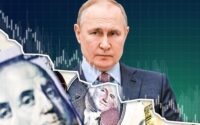US Federal Reserve Chair Jerome Powell faces a crucial choice as the central bank battles the worst bout of inflation since the 1970s: What kind of chair will he be? A Paul Volcker, who took interest rates ever higher in an uncompromising effort to get prices under control? Or an Arthur Burns, who acted more timidly, in the ultimately futile hope that a less austere approach might be sufficient to do the job?
Will Jerome Powell Be Like Volcker or Burns?
So far, he’s looking more like the latter.
To date, the Fed’s monetary tightening hasn’t done much to reduce inflationary pressures or loosen the labor market. As of September, the median consumer price index was up 7.0% from a year earlier, compared with 6.7% in August. Payrolls expanded by 263,000 in September, roughly triple the pace consistent with a stable unemployment rate. The ratio of unfilled jobs to unemployed workers stood at 1.7 in August, far exceeding the 1-to-1 ratio that Powell has cited as appropriate. None of this is consistent with even stable, let alone declining, inflation.
Given the lack of progress, one might expect the Fed to take interest rates even higher than previously planned. Yet officials’ recent remarks suggest they’re sticking to their September projections, which foresee rates increasing 75 basis points in November, 50 in December and 25 in January to a peak of 4.50% to 4.75%. In other words, they intend to take rates to a moderately restrictive level, then wait and see if this constrains growth and increases unemployment enough to bring inflation back down to the central bank’s 2% target. If they don’t get the desired outcome relatively quickly, they’ll keep rates at the peak longer, rather than going higher.
Emphasizing “longer” rather than “higher” has some advantages. It presumably reduces the risk of a hard landing: If monetary policy is somewhat tight, but not very tight, activity and employment should slow gradually. It gives Fed officials time to assess the consequences of their efforts, recognizing that monetary policy entails uncertainty and affects the economy with long and variable lags.
That said, the downside risks are significant. Because less-aggressive tightening takes longer to bring down inflation, it might allow inflationary expectations to become unanchored – a dynamic that only even-higher interest rates could counteract. Also, the rise in rates matters as much as the level of rates. Over time, the effect of the higher level will fade – when, for example, the housing market has completed its adjustment to higher mortgage rates. Once that happens, further rate hikes will be needed to exert further restraint.
There’s no free lunch. To increase its chances of getting inflation back down to 2%, the Fed has to be willing to push short-term interest rates higher when the economy doesn’t slow sufficiently and the labor market remains too tight. That increases the likelihood of recession. Volcker did what was necessary and beat inflation. Burns didn’t, and failed. How does Powell want to be remembered?
More From Bloomberg Opinion:
• Fed Is Giving Americans a Lesson in Lag Time: Allison Schrager
• No Respite for the Federal Reserve on High Inflation: Editorial
• Why Breaking the QE Addiction Is Such a Struggle: Daniel Moss
This column does not necessarily reflect the opinion of the editorial board or Bloomberg LP and its owners.
Bill Dudley is a Bloomberg Opinion columnist and senior adviser to Bloomberg Economics. A senior research scholar at Princeton University, he served as president of the Federal Reserve Bank of New York and as vice chairman of the Federal Open Market Committee.
More stories like this are available on bloomberg.com/opinion
[ad_2]
Source link


